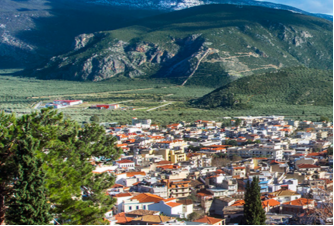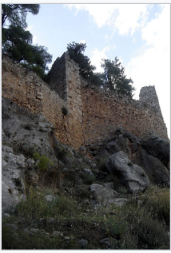Amfissa , Phocis, Central Greece 作者: 来源: 发布时间:2021-03-01
I. Population, Area and Transportation
Total Area: 315.174 km2 (121.689 sq mi)
Lowest Elevation: 180 m (590 ft)
Municipal unit density: 27/km2 (69/sq mi)
Population: 6,919 (2011)
Greek National Road 27 (Greek: Εθνική Οδός 27, abbreviated as EO27) is a single carriageway road in central Greece. It connects the Greek National Road 3 at Bralos, south of Lamia, with the GR-48 near Itea, passing through Amfissa. It is part of the European route E65. The road passes through the regional units Phocis and Phthiotis.

II.Natural Geography (environment and resources)
The town of Amfissa can be described as a hopeless romantic, a fact that you might not expect if you haven’t walked around it and gotten to know its people. This is particularly true during this time of year, when myths come alive and the spirit of the ill-fated Konstantis ‘reawakens’, as locals and visitors alike celebrate a beloved carnival tradition (more on that below).
The town has been inhabited since antiquity, as is evidenced by the walls of its acropolis, on top of which the Castle of Oria was later built. In myth, Amfissa was Apollo’s lover – a fact that makes sense given that it is only about half-an-hour away from ancient Delphi and its sanctuary dedicated to the god of light. It is also only 25 minutes away from seaside Galaxidi, making it a great base for any traveler to the broader area.
As a destination, Amfissa holds much to interest visitors intrigued by the history and evolution of traditions. Because here in the capital of the area of Fokida, there is an abundance of traditions. Thymios Koufalis, the owner of Mikros Kafes (Little Café) in Kehagia Square quotes a well-known lyric by singer-songwriter Dionysis Savvopoulous when describing his town. Amfissa is, he says, “the Greece that resists, the Greece that endures.”
III. ECONOMY
Right now, its economy is based on olive cultivation since there is an enormous area of olive trees named “Amfissa olive tree” where the famous “Amfissa olives” and black olives are produced and collected.
IV. Industrial Characterisitics
-Amfissa is a distribution center for agricultural and livestock products such as wheat, olive and livestock in the nearby area. There are bauxite mines in the southeast suburbs, and aluminum smelters in the city. Right now, its economy is based on olive cultivation since there is an enormous area of olive trees named “Amfissa olive tree” where the famous “Amfissa olives” and black olives are produced and collected. Amfissa is also famous for its carnival.
-Around 1.2 million trees producing the renowned Amfissis olive create “a sea of olive trees” as a foreign poet once described the landscape in the area known as Elaionas (which simply means ‘Olive Grove’ in Greek).
V. Attractions
The medieval castle ("Orias")

At the site of the ancient acropolis, a medieval castle now stands built by the Franks and the Catalans. In its interior one can discern ruins from different time periods. The route to and around the castle is also one of the prettiest walks in Amfissa.
VI. History
-Amfissa has been settled since the ancient times and was the chief town of Ozolian Locris, a region inhabited by the ancient Greek tribe of Locrians; the largest and most renowned town of Locris, beautifully constructed and located one hundred and twenty stades away from Delphi. Pausanias, in his work Description of Greece, mentions the existence of the tombs of Amfissa and Andraemon, and the temple of Athena on the acropolis of the town, with a standing statue of bronze, which was said to have been brought from Troy by Thoas. The Amfissians celebrated mysteries in honor of the "anaktes boys", who might be the Dioskouroi, the Curetes or the Cabeiri (10.38). In Amfissa there were also the tomb of Gorge, wife of Andraemon, and a temple of Asclepius. Recent excavations have revealed a Mycenaean tomb in Amfissa, preliminary findings indicate that the tomb was in use for more than two centuries, from the 13th to the 11th century B.C.
-In 426 BC, Spartan general Eurylochus, on his way to Naupactus, arrived to Delphi and sent a herald to Amfissa, in order to detach them from Athens and make the Amfissians leave him pass through their lands. The latter were the first to give him hostages and also persuaded the other Locrian cities to do the same, as they were alarmed at the hostility of the neighbouring Phocians. After the Peloponnesian War the Amfissians were allies to Thebes. In 395 BC, the Thebans encouraged the Amfissians to collect taxes from territories claimed by both Locris and Phocis; in response, the Phocians invaded Locris, and ransacked Locrian territory and its metropolis, Amfissa. As a result, the Amfissians and the rest of Locrians, along with the Thebans, attacked Phocis, and the Phocians, in turn, appealed to their ally, Sparta. These conflicts led to the Corinthian War, with the Amfissians on the side of Athens, Argos, Corinth and Thebes.
-During the Third Sacred War, 356 - 346 BC, the Amfissians, who were allies of the Thebans, cultivated part of the Crissaean plain, which belonged to Delphi, and founded potteries in Kirra. In 339 BC, the Athenians offered golden shields to the Temple of Apollo in Delphi with inscriptions insulting to the Thebans, who provoked the deputy of Amfissa to oppose to this offer. Then Aeschines, the Athenian deputy, contradicted the Amfissians, introducing their illegal actions in the sacred lands of the Oracle of Delphi before the Amphictyonic League, which called Philip II of Macedon to interfere. In 338 BC, Philip attacked and destroyed Amfissa, expelling large parts of its population and giving the area to Delphi, which is known as the Fourth Sacred War. Later in the same year, under the motivation of Demosthenes, a confederation of the Athenians and the Thebans was organized against the Macedonians, which the Amfissians and the rest of the Ozolian Locrians joined.
-The Amfissians managed to rebuild their town and give to it its former power, but in 322 BC it was sieged by Alexander of Aetolia. In 279 BC, four hundred Amfissian hoplites joined the Greek forces which defended Delphi against the Gauls. Later, the Amfissians and the Aetolians tightened their old affiliation, and in 250 BC, Amfissa joined the Aetolian League as friend and relative of the Aetolians. In 245 BC, Aratus, the strategos of the Achaean League, attacked and damaged Amfissa, but the two leagues allied with the Roman general Titus Quinctius Flamininus against Philip V of Macedon, and after their win over the Macedonian king, Titus proclaimed Amfissa, among other cities, as an independent and tax-exempt polis, capital of Ozolian Locris, with its own Boule, Ecclesia and coins. But when the Aetolians realised that Rome was to rule the Greek cities and asked Antiochus III the Great of Syria for help, the Roman general Manius Acilius Glabrio seized Lamia and advanced to Amfissa, where he conquered the Crissaean plain and besieged the town in 190 BC. The Amfissians, being confident for the power of their acropolis and their walls, defended the city, but the fall of Amfissa to the superior forces of the Romans was likely to happen. Then, Manius Acilius was replaced by Lucius Cornelius Scipio Asiaticus, and the people of Amfissa ran into the acropolis. Athenian deputies intervened and prevented Amfissa from the siege, achieving a truce between the two sides.
-In the period between 174 and 160 BC, Amfissa had been damaged several times during the hostilities which took place between the pro-Roman Aetolians and the nationalists of the town.
-In the early Middle Ages, Amfissa was devastated by several foreign peoples who invaded Greece, like the Visigoths under Alaric I and the Huns. In 451, the town probably had an episcopical seat and in 530, Justinian I fortified the towns around the Crissaean plain and fixed the fortress of Amfissa. Hierocles in his Synecdemus mentions Amfissa as one of the towns of the eparchy of Hellas within the Byzantine Empire, which was under the rule of the vice-consul of Athens.
-Since the middle of the 9th century, new invaders, the Bulgars, raided the region of Phocis and sieged Amfissa several times, but the most damaging was in 996, when Samuel of Bulgaria destroyed the town and slaughtered its people. in 1059, Pechenegs besieged Amfissa one more time and forced the Amfissians to hide in caves of the region to avoid a massacre. In 1147 the Normans arrived to the Crissaean plain but left Amfissa unspoilt, maybe due to the town's decline.
-In 1205, after the Fourth Crusade and the establishment of the Latin Empire, Boniface of Montferrat, the king of Thessalonica, conquered the region of Central Greece. Amfissa became the seat of a lordship under Thomas I d'Autremencourt. It is then that the new governors built the powerful Castle of Salona on the hill where the ancient acropolis of Amfissa existed, while the ancient name of the town was replaced by the new name Salona, or La Sole in French and La Sola in Italian. In 1311, the Catalans conquered and ruled Central Greece for more than eighty years.
-Amfissa dates back to antiquity, with its history spanning around 3,000 years, and has been traditionally the largest and capital city of Phocis. It was the most important city of the ancient Greek tribe of the Ozolian Locrians and one of the most powerful cities in Central Greece.
VII. Other Information
-Archaeologists have announced the discovery of a vaulted Mycenaean tomb near Amfissa, central Greece, containing human remains and a hoard of treasures. The 3,300-year-old tomb is the first of its kind to be found in the region, and one of only a few that have been found untouched. The finding is expected to provide valuable information regarding the habitation, burial customs, and possessions of the Mycenaeans in the 2nd millennium BC.
VIII.Contact Information
Mayor: Athanasios Panagiotopoulos
Town Hall AMFISSA , PARNASSOS , GREECE
Kechagia Square 33100 AMFISSA , PARNASSOS , GREECE
Tel.: +30 22653 51300 , Fax: +30 22653 51333
URL: http://www.dimosdelfon.gr
